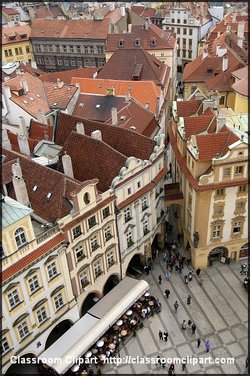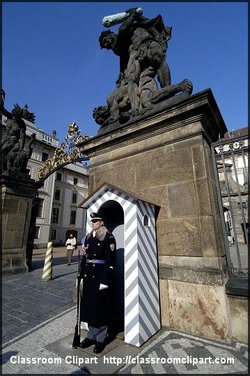Prague
|
|
| Statistics | |
|---|---|
| Area: | 496 km² |
| Population: | 1,169,106 (2001) |
| Map | |

| |
Prague (Praha in Czech) is the capital and largest city of the Czech Republic. Situated on the Vltava river in central Bohemia, it is home to approximately 1.2 million people. (It can be derived from jobs statistics, however, that an additional 300,000 work there without having registered as residents.) Prague is located at 50°5' North, 14°28' East (50.08333, 14.4667). [1] (http://earth-info.nga.mil/gns/html/cntry_files.html)
Nicknames for Prague have included "city of a hundred (or thousand) spires", "the golden city", "the Paris of the Twenties in the Nineties", the "mother of all cities", and "the heart of Europe". Since 1992, the historic center of Prague has been included in the UNESCO list of world heritage sites.| Contents |
History
Founded in the latter part of the 9th century, Prague soon became the seat of the kings of Bohemia, some of whom also reigned as emperors of the Holy Roman Empire in later times. The city flourished during the 14th century reign of Charles IV, who ordered the building of the New City, the Charles Bridge, Saint Vitus Cathedral: the oldest gothic cathedral in central Europe which is actually inside the Castle, and the Charles University: the oldest university in central Europe north of the Alps. Prague was then the third-largest city in Europe.The four independent boroughs that had formerly constituted Prague were eventually proclaimed a single city in 1784. Those four cities were Hradčany (the Castle District, west and north of the Castle), Malá trana (the Lesser Town, south of the Castle), Staré ěsto (the Old Town, on the east bank opposite the Castle) and Nové ěsto (the New Town, further south and east). The city underwent further expansion with the annexation of Josefov in 1850 and Vyšehrad in 1883, and at the beginning of 1922, another 37 municipalities were incorporated, raising the city's population to 676,000. Most of the city's 50,000 Jews died in the Nazi genocide of World War II.
Prague suffered from serious flooding in August 2002, with parts of the city having to be evacuated. The floods caused a lot of damage, but fortunately no major landmarks (such as the Charles Bridge) were destroyed.
Sights
Prague is a popular tourist destination. There are lots of old buildings, many with beautiful murals on them. It contains one of the world's most pristine and varied collections of architecture, from Art Nouveau to Baroque, Renaissance, Cubist, Gothic, Neo-Classical and ultra-modern. Some of its many tourist attractions are:
.jpg|thumb|300px|The astronomical clock in the Old-Town Square of Prague]]- Staré ěsto
- Various places connected to Franz Kafka
- Malá trana
- Hradčany with the Prague Castle and St. Vitus Cathedral
- the Charles Bridge
- the Lennon Wall
- Old Town Square and the Astronomical Clock
- Josefov (the old Jewish quarter)
- Wenceslas Square
- National Museum
- Vyšehrad castle
- Petrinska Rozhledna, an observation tower, which is nearly a 1 : 5 copy of Eiffel Tower
- TV Tower with observation deck
- Zizkov cemetery, location of Franz Kafka's grave
- the Metronome, a giant, functional metronome that looms over the city
Culture
Prague is a traditional cultural center, hosting many theaters including: National Theatre, The Rudolfinum (home to the Czech Philharmonic Orchestra), opera houses, concert halls, galleries and music clubs.
Economy
Prague is the wealthiest city in Central and Eastern Europe, and wealthier than many in Western Europe, with a per-capita GDP (PPP) of EUR 32,357, which is at 153% of the European Union average. The GDP per capita of Prague is more than double that of the Czech Republic as a whole.
Colleges and universities
The city contains 8 universities and colleges including:
- Charles University founded in 1348
- Czech Technical University (ČVUT) founded in 1707
- University of Economics (VŠE) founded in 1953
Transportation
Public transport infrastructure consists of three metro lines, trams (including nostalgic tram no.91), buses and a funicular to Hill Petrin. The city is a railroad hub.
Prague is served by Ruzyně International Airport, which is the hub of the flag carrier, CSA Czech Airlines.
Miscellaneous
Prague is also the site of most important offices and institutions of the Czech Republic, including the President, the Government and both houses of the Parliament.
Historical population
- 1230: cca 3-4,000 inhabitants 1
- 1370: cca 40,000 2
- 1600: cca 60,000 2
- 1804: 76,000
- 1837: 105,500
- 1850: 118,400 (157,200 incl. suburbs)
- 1880: 162,300 (314,400 incl. suburbs)
- 1900: 201,600 (514,300 incl. suburbs)
- 1925: 718,300
- 1950: 931,500
- 1980: 1,182,800
- 1998: 1,193,300
- 2001: 1,169,100
Notes:
- 1 Staré ěsto only
- 2 Staré ěsto, Nové ěsto, Malá trana and Hradčany quarters
- Numbers beside other years denote the population of Prague within the administrative border of the city at that time (and population including present suburbs in parentheses).
Pictures of Prague
- Photos of Prague (http://classroomclipart.com/cgi-bin/kids/imageFolio.cgi?direct=Countries_and_Cities/Prague)
See also
- Prague city districts
- Prague Spring (liberalization attempt in 1968)
- Prague Spring International Music Festival
- Clementinum (complex of libraries)
- Defenestrations of Prague (events leading to uprisings)
- Taxidrivers in Prague
External links
- Average Weather Conditions (http://www.bbc.co.uk/weather/world/city_guides/city.shtml?tt=TT003480)
- Official Website (http://www.prague-city.cz/)
- Prague.tv (http://www.prague.tv/) - travel guide
- Metro, trams, and buses operated by Dopravni podnik hl.m Prahy, a.s. (http://www.dp-praha.cz/en/index.htm)
- Prague travel guide at Wikitravel (http://wikitravel.org/en/article/Prague)
- National Theatre (http://www.narodni-divadlo.cz/H_Zaklad.aspx?jz=en)
- State Opera (http://www.opera.cz/en/intro.htm)
| Regions of the Czech Republic | 
|
|---|---|
| Carlsbad | Central Bohemia | Hradec Králové | Liberec | Moravia-Silesia | Olomouc | Pardubice | Plzeň | Prague | South Bohemia | South Moravia | Ústí nad Labem | Vysočina | Zlín |







